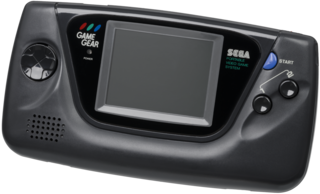
The Game Gear is an 8-bit fourth generation handheld game console released by Sega on October 6, 1990, in Japan, in April 1991 throughout North America and Europe, and during 1992 in Australia. The Game Gear primarily competed with Nintendo's Game Boy, the Atari Lynx, and NEC's TurboExpress. It shares much of its hardware with the Master System, and can play Master System games through the use of an adapter. Sega positioned the Game Gear, which had a full-color backlit screen with a landscape format, as a technologically superior handheld to the Game Boy.

Sonic the Hedgehog is a 1991 platform game. It is a companion to the 16-bit Sega Genesis game Sonic the Hedgehog for the 8-bit Sega Master System and Game Gear consoles. Ancient—a studio founded by composer Yuzo Koshiro for the project—developed the game and Sega published it to promote the handheld Game Gear. The 8-bit Sonic is a side-scrolling game similar in style to the 16-bit game, but reduced in complexity to fit the 8-bit systems.

Wonder Boy in Monster Land, known by its original arcade release as Wonder Boy: Monster Land, is a platform video game developed by Westone Bit Entertainment and released by Sega in Japanese arcades in 1987 and for the Master System in 1988, with a number of other home computer and console ports following. The game is the sequel to the 1986 game Wonder Boy and takes place eleven years after the events in the previous game. After enjoying over a decade of peace on Wonder Land following the defeat of the evil King by Tom-Tom, later bestowed the title "Wonder Boy", a fire-breathing dragon called the MEKA dragon appeared; he and his minions conquered Wonder Land, turning it into "Monster Land". The people, helpless due to their lack of fighting skill, call for Wonder Boy, now a teenager, to destroy the monsters and defeat the MEKA dragon. Players control Wonder Boy through twelve linear levels as he makes his way through Monster Land to find and defeat the MEKA dragon. Players earn gold by defeating enemies and buy weapons, armor, footwear, magic, and other items to help along the way.

Out Run is an arcade driving video game released by Sega in September 1986. It is known for its pioneering hardware and graphics, nonlinear gameplay, a selectable soundtrack with music composed by Hiroshi Kawaguchi, and the hydraulic motion simulator deluxe arcade cabinet. The goal is to avoid traffic and reach one of five destinations.
2.5D perspective refers to gameplay or movement in a video game or virtual reality environment that is restricted to a two-dimensional (2D) plane with little or no access to a third dimension in a space that otherwise appears to be three-dimensional and is often simulated and rendered in a 3D digital environment.

Space Harrier is a third-person arcade rail shooter game developed by Sega and released in 1985. It was originally conceived as a realistic military-themed game played in the third-person perspective and featuring a player-controlled fighter jet, but technical and memory restrictions resulted in Sega developer Yu Suzuki redesigning it around a jet-propelled human character in a fantasy setting. The arcade game is controlled by an analog flight stick while the deluxe arcade cabinet is a cockpit-style linear actuator motion simulator cabinet that pitches and rolls during play, for which it is referred as a taikan (体感) or "body sensation" arcade game in Japan.
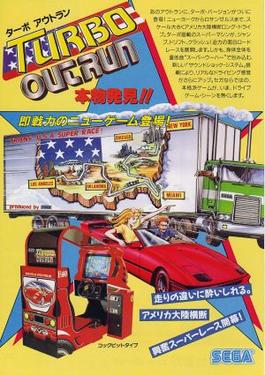
Turbo OutRun (ターボアウトラン) is a 1989 arcade racing game released by Sega. A follow-up to 1986's Out Run, it was released as a dedicated game, as well as an upgrade kit for the original Out Run board.
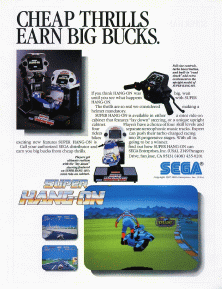
Super Hang-On is a motorcycle racing arcade video game released by Sega as the sequel to Hang-On. It uses a simulated motorcycle arcade cabinet, like the original game. An updated version was released in arcades 1991 as Limited Edition Hang-On.

Wonder Boy III: The Dragon's Trap, known as Monster World II in Japan, is a platforming action-adventure video game developed by Westone as part of Sega's Wonder Boy series. It was published by Sega and released for the Master System in 1989 and for the Game Gear in 1992 as Wonder Boy: The Dragon's Trap. It was ported by Hudson Soft and released in 1991 for the TurboGrafx-16/PC Engine under the name Dragon's Curse. It was also ported in 1993 by Brazilian company Tec Toy under the title Turma da Mônica em o Resgate, with the game retooled to include characters from Brazilian comic book series Monica's Gang. A remake developed by Lizardcube and published by DotEmu, titled Wonder Boy: The Dragon's Trap, was released in April 2017.

Sonic the Hedgehog 2 is a 1992 platform game developed by Aspect and published by Sega for the Master System and Game Gear. It is the sequel to the 8-bit Sonic the Hedgehog (1991) and follows Sonic as he attempts to get the Chaos Emeralds back to rescue his friend Miles "Tails" Prower from Dr. Robotnik. Like the first Sonic the Hedgehog, players run through levels at high speeds while collecting rings and defeating enemies. Although it shares the same title with Sonic the Hedgehog 2 for the Sega Genesis and their releases coincided, the games have little in common and share no levels.

Ayrton Senna's Super Monaco GP II is an arcade-style Formula One racing video game developed and manufactured by Sega for the Sega Genesis and Mega Drive, Master System, and the Game Gear in 1992. It is a follow-up to Super Monaco GP. The game was also endorsed by, and had technical input from, the then-Formula One champion Ayrton Senna. Gameplay includes a World Championship season featuring recreations of the tracks in the 1991 Formula One World Championship, along with a three-race "Senna GP" mode set on fictional tracks.

Super Monaco GP is a Formula One racing simulation video game released by Sega, originally as a Sega X Board arcade game in 1989, followed by ports for multiple video game consoles and home computers in the early 1990s. It is the sequel to the 1979 arcade game Monaco GP. The arcade game consists of one race, the Monaco Grand Prix, but later ports added more courses and game modes based on the 1989 Formula One World Championship.
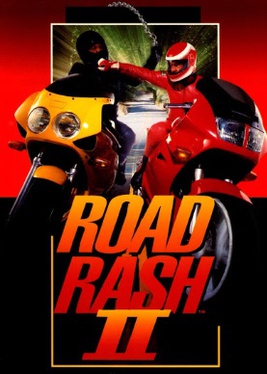
Road Rash II is a 1992 racing and vehicular combat game developed and published by Electronic Arts (EA) for the Sega Genesis. The game is centered around a series of motorcycle races throughout the United States that the player must win to advance to higher-difficulty races, while engaging in unarmed and armed combat to hinder the other racers. It is the second installment in the Road Rash series and introduces a split-screen two-player mode for competing human players, nitrous oxide charges on certain bikes, and chains as offensive weapons.

Fantasy Zone II: The Tears of Opa-Opa is a horizontally scrolling shooter for the Master System published by Sega in 1987. It was ported to the arcade, Famicom, and MSX2, and was remade for the System 16 hardware on a PlayStation 2 compilation in 2008. It was re-released on the Wii Virtual Console in North America on June 29, 2009. Like the first Fantasy Zone, the player controls a sentient spaceship named Opa-opa who fights surreal invader enemies. Like its predecessor, Fantasy Zone II departs from scrolling shooter themes with its bright colors and whimsical designs. For this reason, it is occasionally dubbed a "cute 'em up".
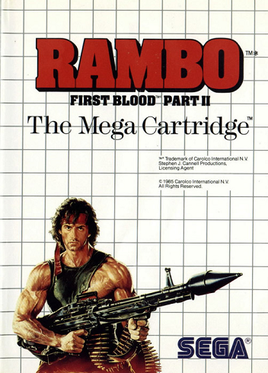
Rambo: First Blood Part II is an overhead run and gun video game loosely based on the 1985 film of the same name that was published in North America by Sega for the Master System in 1986 and then re-released as a budget title in 1990. It was originally released in Japan as Ashura, where it was released without the Rambo license.
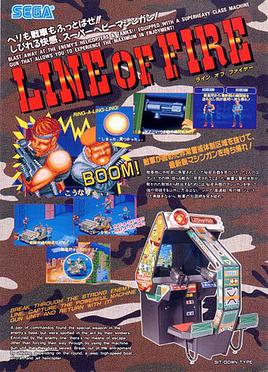
Line of Fire is a first-person light gun shooter game developed by Sega and released for arcades in 1989. It was released with two arcade cabinet versions, a standard upright and a sit-down cockpit, both featuring two positional guns. The cockpit design allows the player(s) to sit down while playing the game, while having two-handed machine guns, controlled by a potentiometer-controlled gun alignment software system. The game follows a two-man commando unit as they try to escape from a terrorist facility after seizing a prototype weapon.
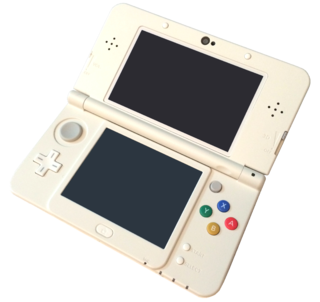
A stereoscopic video game is a video game which uses stereoscopic technologies to create depth perception for the player by any form of stereo display. Such games should not be confused with video games that use 3D game graphics on a mono screen, which give the illusion of depth only by monocular cues but lack binocular depth information.

Road Rash is a 1991 racing and vehicular combat video game originally developed and published by Electronic Arts (EA) for the Sega Genesis. It was subsequently ported to a variety of contemporary systems by differing companies. The game is centered around a series of motorcycle races throughout California that the player must win to advance to higher-difficulty races, while engaging in unarmed and armed combat to hinder the other racers.
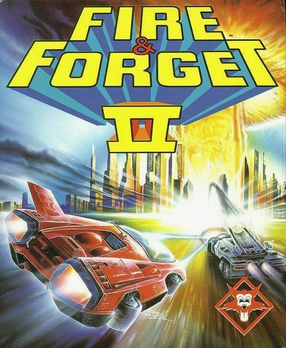
Fire & Forget II is a 1990 futuristic racing-shooter video game developed by Titus Arcade and published by Sega for the Master System, and by Amstrad for the GX4000. It is the sequel to Fire and Forget, which was developed by Titus France SA for a number of platforms including the ZX Spectrum. Fire & Forget II is one of a number of similar games which emerged in the late 1980s and early 1990s in the wake of Sega's popular arcade driving game Out Run (1986). It is notable for the variety of its enemy sprites, and for its use of parallax scrolling. It is also notable for being one of the first video games to be launched simultaneously on two consoles.

Road Rash is a 1994 racing and vehicular combat video game originally published by Electronic Arts (EA) for the 3DO Interactive Multiplayer. A version for the Sega CD was developed simultaneously and released in 1995 to act as a "bridge" between the 3DO version and the Sega Genesis title Road Rash 3, and the game was subsequently ported to the PlayStation, Sega Saturn, and Microsoft Windows in 1996. The game is the third installment in the Road Rash series, and is centered around a series of motorcycle races throughout California that the player must win to advance to higher-difficulty races, while engaging in unarmed and armed combat to hinder the other racers.



















